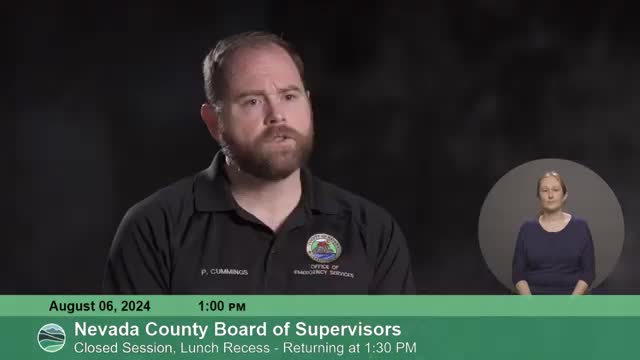Prepare Now to Become a Hero This Fire Season
August 06, 2024 | Nevada County, California
This article was created by AI summarizing key points discussed. AI makes mistakes, so for full details and context, please refer to the video of the full meeting. Please report any errors so we can fix them. Report an error »

In a recent community meeting focused on emergency preparedness, local officials and residents shared vital insights on the importance of having a well-prepared \"go bag\" for potential evacuations. Ulysses Palencia, a representative from the 211 call center, emphasized that a go bag should contain essential items such as food, water, medication, clothing, and toiletries to sustain individuals and their families for up to 72 hours during an emergency.
Palencia highlighted the critical need for individuals with disabilities or chronic health conditions to include necessary medical equipment in their go bags, such as CPAP machines or insulin pumps. He recounted personal experiences from past evacuations, illustrating how community connections can be lifesaving during disasters. Many residents shared stories of how neighbors played crucial roles in their escape during emergencies, underscoring the importance of having a reliable support network.
The meeting also addressed the types of evacuation notifications, distinguishing between evacuation warnings—alerts about potential threats—and evacuation orders, which indicate an imminent danger requiring immediate action. Officials discussed the Code Red alert system, which provides targeted notifications via phone calls, texts, and emails to keep residents informed.
Participants were encouraged to develop personal emergency plans, including establishing a designated meeting place for family members during a disaster. The emphasis was placed on community engagement and preparedness, with officials urging residents to communicate with neighbors and participate in local emergency response initiatives.
As fire season approaches, the message was clear: preparedness is key, and every individual has the power to be a hero in their community by being ready to act when the need arises. Local agencies are committed to supporting residents in their preparedness efforts, ensuring that everyone knows they can reach out for assistance.
Palencia highlighted the critical need for individuals with disabilities or chronic health conditions to include necessary medical equipment in their go bags, such as CPAP machines or insulin pumps. He recounted personal experiences from past evacuations, illustrating how community connections can be lifesaving during disasters. Many residents shared stories of how neighbors played crucial roles in their escape during emergencies, underscoring the importance of having a reliable support network.
The meeting also addressed the types of evacuation notifications, distinguishing between evacuation warnings—alerts about potential threats—and evacuation orders, which indicate an imminent danger requiring immediate action. Officials discussed the Code Red alert system, which provides targeted notifications via phone calls, texts, and emails to keep residents informed.
Participants were encouraged to develop personal emergency plans, including establishing a designated meeting place for family members during a disaster. The emphasis was placed on community engagement and preparedness, with officials urging residents to communicate with neighbors and participate in local emergency response initiatives.
As fire season approaches, the message was clear: preparedness is key, and every individual has the power to be a hero in their community by being ready to act when the need arises. Local agencies are committed to supporting residents in their preparedness efforts, ensuring that everyone knows they can reach out for assistance.
View full meeting
This article is based on a recent meeting—watch the full video and explore the complete transcript for deeper insights into the discussion.
View full meeting
